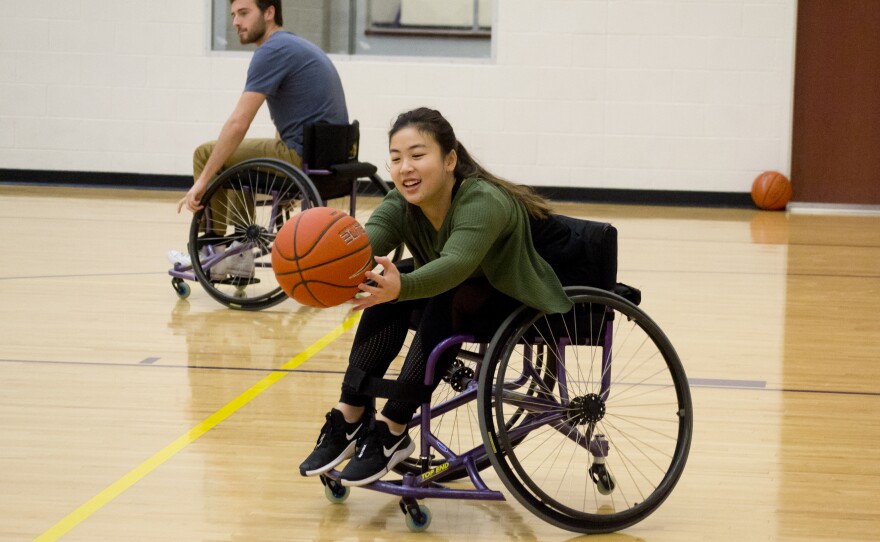Last week, kinesiology students at JMU attended workshops led by U.S. Paralympians and local wheelchair basketball players. The students' task: to learn how their studies in human movement intersect with the lives of those living with physical disabilities. WMRA’s Randi Hagi reports.
[Basketball at UREC]
Two gyms at JMU’s University Recreation Center, or UREC, were filled with college students dribbling basketballs last Thursday morning. But the unusual part is that the students – all of whom could walk – were dashing around in narrow wheelchairs with no armrests, their wheels canted out towards the floor. Altogether, 200 students in a 100-level Kinesiology course, plus 10 from Bridgewater College, participated in the Paralympic Skill Lab organized by Kinesiology Professor Cathy McKay.
CATHY McKAY: The main goal for today is for students to shift the paradigm through which they see ability or disability. So when students have contact with people who are different than themselves, and in this case that’s Paralympic athletes or our local adapted sport athletes, we find that they come to know and understand that individuals with physical disabilities are really just like you and I, and that helps to break down some of those barriers, and helps to inform their perceptions on ability and on access and inclusion.
The day began with a screening of the documentary “The Rebound,” which follows a Miami wheelchair basketball team on their quest for the NWBA Championship. The documentary was directed by Shaina Allen, a 2011 graduate of JMU, and produced and filmed by Mike Esposito, a 2010 graduate. The award-winning documentary is set to be released on Netflix on February 28.
Basketball players Jacob Tyree, Brandon Rush, and Tom Vandever from the Charlottesville Cardinals, and Paralympic gold medalist Trevon Jenifer led the basketball labs – teaching the students how to dart across the court, pass, block, and shoot from their chairs. Across the hall, Paralympic Sitting Volleyball player Nicky Nieves [Neh-vuhs] and Paralympic Goalball player Matt Simpson held workshops on their sports. If you’ve never heard of “goalball,” it’s a sport specifically created for the visually impaired. Players aim to score points by shooting a ball filled with bells into their opponent’s goal: a net which stretches across the entire back line of the court. Simpson, a law student at the University of Virginia, became legally blind at a young age.
MATT SIMPSON: As a person with a disability, it can be debilitating – not to have a disability, but to have people around you set incredibly low expectations for you as a human being. And so I hope that people who come learn about Paralympic sports get to hear us talk, get to interact with us, I hope that they will continue to raise the expectations for themselves, but also for people with disabilities around them.
Off the court, Simpson’s guide dog, “Lacrosse,” helps him navigate. But on the court, Simpson, like all goalball players, wears darkened goggles to eliminate any remaining sight – the athletes rely on sound to track the heavy ball. As students practiced this skill, they clapped to let their teammates know where to pass the ball.
[Goalball ambience]
Simpson came to the realization, in college, that his obstacle to being an athlete wasn’t his disability – it was his lack of conditioning, and how hard he was willing to work. He went on to win a silver medal at the 2016 Paralympic Games.
Nicky Nieves echoed Simpson’s sentiments of togetherness. She runs the nonprofit Limitless People Inc., which teaches and promotes both sitting and standing volleyball in Florida and the Dominican Republic.
NICKY NIEVES: What I hope they take away is that, sports are sports, and it’s for everybody. Just kind of break that boundary and have it just be all-inclusive, like it’s for everybody, whether you are able-bodied or not able-bodied, whether you can or cannot, if you can try, then try, and just have it be all-inclusive. Just because you have both arms, both legs, doesn’t mean you can’t play wheelchair basketball, or you can’t play sitting volleyball.
Ben Cotton, a JMU senior who participated in the wheelchair basketball portion of the lab, quickly applied the morning’s experience to his engineering major.
BEN COTTON: Well, in talking to some of the athletes at the end, they were talking about how it’s hard to move laterally, and so if someone comes on the side, and you have to shift, first you have to turn and then you can come towards them to defend. So I was thinking, maybe, thinking about different ways to make it easier for the wheelchairs to be designed so you can move laterally a little more quickly.
JMU’s UREC Center owns 10 of the wheelchairs, which can be checked out, like a basketball, for student use. McKay also encouraged students to join one of their weekly wheelchair basketball pickup games, or the intramural tournament this Spring.









